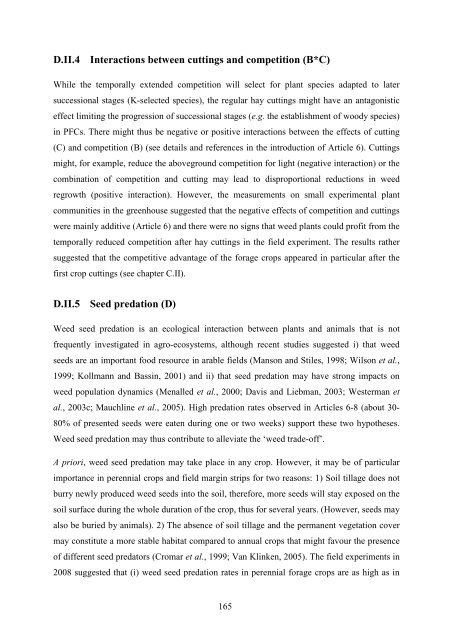Diversifying crop rotations with temporary grasslands - Université de ...
Diversifying crop rotations with temporary grasslands - Université de ...
Diversifying crop rotations with temporary grasslands - Université de ...
You also want an ePaper? Increase the reach of your titles
YUMPU automatically turns print PDFs into web optimized ePapers that Google loves.
D.II.4 Interactions between cuttings and competition (B*C)<br />
While the temporally exten<strong>de</strong>d competition will select for plant species adapted to later<br />
successional stages (K-selected species), the regular hay cuttings might have an antagonistic<br />
effect limiting the progression of successional stages (e.g. the establishment of woody species)<br />
in PFCs. There might thus be negative or positive interactions between the effects of cutting<br />
(C) and competition (B) (see <strong>de</strong>tails and references in the introduction of Article 6). Cuttings<br />
might, for example, reduce the aboveground competition for light (negative interaction) or the<br />
combination of competition and cutting may lead to disproportional reductions in weed<br />
regrowth (positive interaction). However, the measurements on small experimental plant<br />
communities in the greenhouse suggested that the negative effects of competition and cuttings<br />
were mainly additive (Article 6) and there were no signs that weed plants could profit from the<br />
temporally reduced competition after hay cuttings in the field experiment. The results rather<br />
suggested that the competitive advantage of the forage <strong>crop</strong>s appeared in particular after the<br />
first <strong>crop</strong> cuttings (see chapter C.II).<br />
D.II.5 Seed predation (D)<br />
Weed seed predation is an ecological interaction between plants and animals that is not<br />
frequently investigated in agro-ecosystems, although recent studies suggested i) that weed<br />
seeds are an important food resource in arable fields (Manson and Stiles, 1998; Wilson et al.,<br />
1999; Kollmann and Bassin, 2001) and ii) that seed predation may have strong impacts on<br />
weed population dynamics (Menalled et al., 2000; Davis and Liebman, 2003; Westerman et<br />
al., 2003c; Mauchline et al., 2005). High predation rates observed in Articles 6-8 (about 30-<br />
80% of presented seeds were eaten during one or two weeks) support these two hypotheses.<br />
Weed seed predation may thus contribute to alleviate the ‘weed tra<strong>de</strong>-off’.<br />
A priori, weed seed predation may take place in any <strong>crop</strong>. However, it may be of particular<br />
importance in perennial <strong>crop</strong>s and field margin strips for two reasons: 1) Soil tillage does not<br />
burry newly produced weed seeds into the soil, therefore, more seeds will stay exposed on the<br />
soil surface during the whole duration of the <strong>crop</strong>, thus for several years. (However, seeds may<br />
also be buried by animals). 2) The absence of soil tillage and the permanent vegetation cover<br />
may constitute a more stable habitat compared to annual <strong>crop</strong>s that might favour the presence<br />
of different seed predators (Cromar et al., 1999; Van Klinken, 2005). The field experiments in<br />
2008 suggested that (i) weed seed predation rates in perennial forage <strong>crop</strong>s are as high as in<br />
165

















